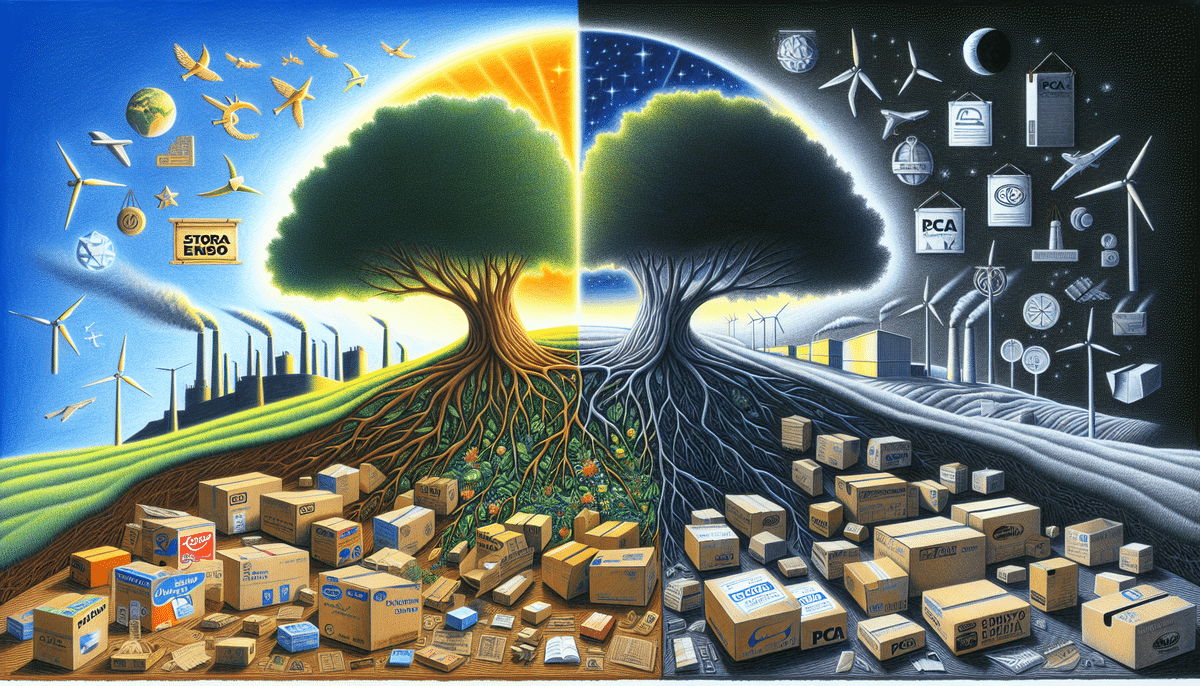Introduction to Stora Enso and Packaging Corporation of America (PCA)
In the global packaging industry, Stora Enso and Packaging Corporation of America (PCA) stand out as two prominent leaders. Stora Enso, a Finnish-Swedish multinational, has established a significant global footprint, while PCA, based in the United States, primarily operates within North America. This comparison explores their histories, market positions, product offerings, financial performances, sustainability initiatives, and strategic developments to understand their impact on the packaging sector.
Company Histories
Stora Enso
Founded in 1998 through the merger of Stora Kopparberg and Enso-Gutzeit, Stora Enso has evolved into one of the world's largest forestry companies. Initially concentrating on paper production, the company diversified into packaging, biomaterials, and wood products. Stora Enso has consistently prioritized sustainability, aiming for carbon neutrality by 2030 and adhering to responsible forestry practices, earning multiple certifications for sustainable forest management.
Packaging Corporation of America (PCA)
Packaging Corporation of America (PCA) was established in 1959, focusing primarily on producing corrugated shipping containers. Over the decades, PCA expanded its product range through strategic acquisitions and innovations, solidifying its presence in the North American market. The company emphasizes sustainability by reducing waste and increasing the use of recycled materials in its products.
Market Position and Financial Performance
Global Market Presence
The global packaging market is anticipated to grow at a compound annual growth rate (CAGR) of approximately 3.5% from 2021 to 2026, driven by increasing demand for sustainable packaging solutions. Stora Enso leverages its extensive global operations, particularly in Europe and Asia, to capture emerging market opportunities. Conversely, PCA maintains a stronghold in North America, with recent expansions into Europe and Asia through acquisitions.
Financial Highlights
- Stora Enso: In 2022, Stora Enso reported revenues of €11 billion, reflecting a steady growth trajectory supported by its diversified product portfolio and sustainability initiatives. The company's investment in renewable energy sources, such as biomass and wind power, has contributed to its financial resilience.
- PCA: PCA reported revenues of $7.5 billion in 2022, marking a growth from previous years. Strategic acquisitions, including the purchase of TimBar Packaging, have enhanced PCA's market reach and product offerings, driving its financial performance.
Both companies demonstrate robust financial health, enabling continued investment in expanding operations and enhancing product lines.
Products and Services Offered
Stora Enso
Stora Enso offers a comprehensive range of packaging products, including paperboard, containerboard, and corrugated boxes. Additionally, the company provides innovative sustainable packaging solutions and packaging design services. Beyond packaging, Stora Enso produces various paper products such as printing and writing papers, specialty papers, and pulp, continuously innovating to meet evolving customer needs.
Packaging Corporation of America (PCA)
PCA specializes in corrugated packaging solutions, including containers, sheets, and retail packaging. The company serves a broad range of industries, notably the food and beverage sector, providing packaging for fresh produce, meat, dairy, and more. PCA also offers packaging design services to help clients create visually appealing and effective packaging that stands out on store shelves.
Both companies emphasize sustainability in their product offerings, striving to reduce waste and utilize renewable materials in their packaging solutions.
Sustainability and Environmental Policies
Stora Enso's Sustainability Initiatives
Stora Enso is committed to achieving carbon neutrality by 2030. The company leverages renewable materials in its packaging solutions and invests in advanced bioproducts, such as lignin-based carbon fiber, to expand its environmentally friendly options. These efforts align with global sustainability goals and enhance the company's reputation as a leader in sustainable packaging.
PCA's Sustainability Efforts
PCA focuses on waste reduction and the increased use of recycled materials in its products. The company has set targets for reducing its carbon footprint and enhancing the sustainability of its packaging solutions. PCA's adoption of innovative technologies, such as the Box On Demand system, helps minimize waste and improve operational efficiency.
Both Stora Enso and PCA have received recognition for their environmental efforts, underscoring their roles in promoting sustainability within the packaging industry.
Strategic Developments and Innovation
Technological Investments
To stay competitive, both companies are heavily investing in technology and innovation:
- Stora Enso: The company invests in digitalization and automation to enhance efficiency and reduce costs. Collaborations with companies like H&M and Sulapac have led to the development of biodegradable retail packaging materials.
- PCA: PCA has implemented digital solutions to streamline operations and launched innovative systems like Box On Demand, which allows customers to produce custom-sized boxes on demand, reducing waste and enhancing efficiency.
Acquisitions and Partnerships
- Stora Enso: Acquired Cellutech AB, a leading producer of renewable foam materials, to broaden its product offerings. Partnerships with retailers have accelerated the development of sustainable packaging solutions.
- PCA: Acquired TimBar Packaging and Sacramento Container to expand its product range and market reach, reinforcing its position in the North American and global markets.
These strategic moves demonstrate both companies' commitment to innovation, sustainability, and market expansion within the packaging industry.
Future Prospects
Both Stora Enso and PCA are poised to capitalize on the growing demand for sustainable packaging solutions:
- Stora Enso: Its diversified business model and extensive global presence provide a solid foundation for ongoing growth. Continued investment in renewable materials and sustainable practices positions the company to meet future market demands.
- PCA: PCA's specialization in corrugated packaging allows for continuous improvement and innovation within its niche. Strategic acquisitions and technological advancements will likely drive future growth and competitiveness.
Their strong financial positions and commitment to sustainability ensure that both companies will remain influential players in the packaging industry, adapting to evolving consumer preferences and environmental regulations.
Conclusion
Stora Enso and Packaging Corporation of America (PCA) each exhibit unique strengths within the global packaging industry. Stora Enso's diversified and globally integrated operations complement its robust sustainability initiatives, while PCA's specialized focus on corrugated packaging and strategic expansions bolster its market position. Both companies demonstrate a commitment to innovation and environmental responsibility, positioning them well to navigate future challenges and capitalize on emerging opportunities in the packaging sector.




















